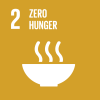
Volume of production per labour unit by classes of farming/pastoral/forestry enterprise size
Last updated on 1 February 2022
This indicator is currently classified as Tier II. The Food and Agriculture Organization of the United Nations (FAO) is the Custodian agency for this indicator.
Unit of measure: Value of production per labour day of small-scale food producers (in constant PPP USD 2011)
Why is this indicator important?
Small-scale food producers constitute the majority of food producers in many countries. Accordingly, enhancing sustainable food production systems and resilient agricultural practices of small-scale producers is important to combat hunger. Developing efficient and robust food production programs to boost agricultural productivity of small-scale producers is essential to maintain food supplies, increase incomes for poor and vulnerable groups, and feed the planet. It also contributes to strengthening rural development. Together with indicator 2.3.2., it defines small-scale producers and provides insights into how much they earn and produce.
By tracking the volume of production per labour unit by classes of farming/pastoral/forestry enterprise size, data collected for indicator 2.3.1 enables governments to shape, prioritize, and invest in policies and measures that effectively boost agricultural productivity, drive economic growth, and eliminate hunger in particular for small-scale food producers, including women, Indigenous Peoples, family farmers, and pastoralists.
How is the indicator measured and monitored?
Data and information on rural income, livelihoods, and labour inputs is limited in many countries. Moreover, information is usually collected on household level instead of food production unit level.
According to the metadata brief, sources of information are either agricultural surveys, or agricultural modules in integrated household surveys (e.g., LSMS-ISA) organized by the national statistical agencies, with the necessary support from the World Bank, FAO and other international agencies. FAO has been working on computing the indicator for eight developing countries in Sub-Saharan Africa based on data collected from the Living Standards Measurement Study-Integrated Surveys on Agriculture (LSMS-ISA) surveys. Results have not been disseminated yet. In collaboration with IFAD and the World Bank, FAO also promotes the Agricultural and Rural Integrated Surveys project (AGRISurvey) which aims to assist countries to collect relevant data on an annual basis.
By Anne Hennings, peer-reviewed by FAO.
Official indicator data
Volume of agricultural production of small-scale food producer in crop, livestock, fisheries, and forestry activities. The indicator is computed as a ratio of annual output to the number of working days in one year.
* Select "year" below to see the most recent data for more countries.
Other related indicators on Land Portal
In addition to the official indicator data, the following indicators provide information concerning the importance of agriculture in a given country or the distribution of land.
| Indicator | Min-Max Number of years |
Countries / Obs | Min / Max Value |
|---|---|---|---|
| Average size of holdings (ha) | |||
| Employees in Agriculture - Female (% of female employment) | |||
| Employment in Agriculture (% Total Employment) |
Living the best of both worlds
Imagine a world where sustainable development is no longer an oxymoron, one where the Earth is economically and ecologically stable and food and energy needs are met. It’s a place where habitats are preserved and pollution is limited.
Don’t worry – you’re not alone if you can’t.
But according to a recent study published in The Ecological Society of America, this vision is not just imaginable, but it’s attainable. And by 2050 no less.
Land and the SDGs
By Professor Jeffrey Sachs, Chairman of the Advisory Board of CCSI, University Professor at Columbia University, and Director of the UN Sustainable Development Solutions Network
Africa’s growth lies with smallholder farmers
AS the world’s population surges towards nine billion by midcentury, food production has failed to keep pace, creating rising food shortages and a global food crisis ahead, according to the United Nations. To avoid mass starvation, the world needs to produce 70% more food by 2050.
Zimbabwe: ZAS official admits agricultural output gone down since land reform
THE Zimbabwe Agricultural Society (ZAS) has admitted agricultural production in the country has been on a downward trend and on Tuesday announced it would introduce a new section aimed at encouraging farmers to improve their yields.
ZAS CEO, Anxious Masuka, told reporters at a press conference in Harare they would launch the Eleven Tonne Plus Club which will celebrate the cream of Zimbabwean farmers who have excelled in maize production.
Pagination
- Page 1
- Next page next ›
Metadata on SDGs Indicator 2.3.1
Indicator 2.3.1: Volume of production per labour unit by classes of farming/pastoral/forestry enterprise
size
Relations between land tenure security and agricultural productivity: Exploring the effect of land registration
This paper reviews the scholarly literature discussing the effect(s) of land registration on the relations between land tenure security and agricultural productivity. Using 85 studies, the paper focuses on the regular claim that land registration's facilitation of formal documents-based land dealings leads to investment in a more productive agriculture.
Space-based SAR and optical remote sensing for productivity monitoring and mapping of sugarcane
In this study, research on productivity and land cover monitoring is presented, with a focus on sugarcane, based on space-based remote sensing observations that were collected by Synthetic Aperture Radar (SAR) and optical sensors.
Impact of land security on household’s agricultural productivity in Benin
This paper studies the impact of land tenure on household agricultural productivity in Benin. Compared to households without land ownership or right to land (squatters), results show that land certificate ownership increases by 0.238 the likelihood of investing in agricultural equipment, whereas customary law ownership increases this likelihood by 0.374.
Agricultural Productivity in Africa.Trends, Patterns, and Determinants
The publication presents updated and new analyses of land, labor, and total productivity trends in African agriculture. It brings together analyses of a unique mix of data sources and evaluations of public policies and development projects to recommend ways to increase agricultural productivity in Africa.
Pagination
![]()

By 2030, double the agricultural productivity and incomes of small-scale food producers, in particular women, indigenous peoples, family farmers, pastoralists and fishers, including through secure and equal access to land, other productive resources and inputs, knowledge, financial services, markets and opportunities for value addition and non-farm employment
Indicator details
The indicator is conceptually clear, has an internationally established methodology and standards are available, but data is not regularly produced by countries.
Key dates:





